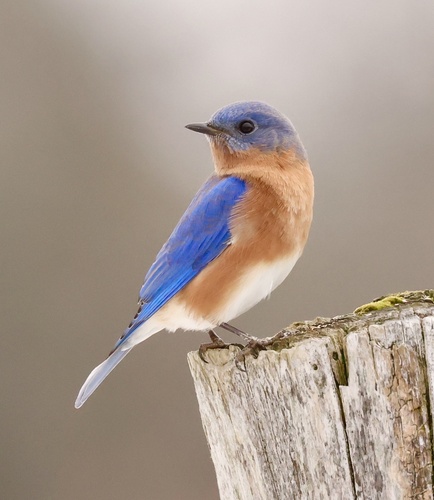
Eastern Bluebird
The Eastern Bluebird (Sialia sialis) is a small thrush found across North America, celebrated for its vibrant blue plumage and melodious song. It plays a crucial role in its ecosystem as an insectivore, helping to control insect populations, and also disperses seeds, contributing to plant propagation. Culturally, the Eastern Bluebird is often seen as a symbol of happiness, spring, and renewal, featuring prominently in folklore and literature.
16-21 cm
Length
25-32 cm
Wingspan
Least Concern
Conservation Status
Distribution
Eastern Bluebirds are found east of the Rocky Mountains, ranging from southeastern Canada to the Gulf Coast and extending into parts of Central America. They have a limited presence in the southwestern United States. Migratory populations breed in the northern parts of their range and winter in the south.
Lifespan
Typically 6-10 years in the wild, although many survive only their first year.
Eastern Bluebird's Habitat
Habitat Types
Open woodlands, Farmlands, Orchards, Parks, Suburban areas with scattered trees
Climate Zones
Temperate, Subtropical
Adaptations
Eastern Bluebirds prefer habitats with open ground and low ground cover for foraging, as well as suitable cavity trees or nest boxes for nesting. Their perching behavior is well-suited for spotting insects on the ground.
Variations
Several subspecies are recognized, differing slightly in size and coloration. For instance, *Sialia sialis bermudensis*, found in Bermuda, is noted for its brighter blue plumage and larger size compared to mainland populations.
Appearance
Breeding Plumage
Breeding males have bright blue upperparts, a reddish-brown throat and breast, and a white belly. Females have duller blue-gray upperparts and a paler orange-brown breast. Non-breeding plumage is similar, but colors may be slightly less intense.
Seasonal Feather Changes
Plumage is generally brightest during the breeding season. Molting occurs post-breeding, resulting in a slightly duller appearance.
Sex Based Plumage Differences
Significant sexual dimorphism exists, with males exhibiting much brighter blue coloration than females.
Notable Features
Bright blue upperparts (in males), Reddish-brown breast, White belly, Rounded head and plump body
Diet and Feeding
Primary Foods
Insects, Spiders, Berries, Fruits, Seeds
Foraging Behavior
Eastern Bluebirds typically perch on low branches or fence posts and scan the ground for insects. They then swoop down to capture their prey. They also glean insects from foliage and occasionally hover to catch flying insects.
Specializations
Their keen eyesight is adapted for spotting small insects from a distance. Their relatively short, slender bills are well-suited for catching insects.
Seasonal Diet Variations
Their diet shifts seasonally. Insects and other arthropods are the primary food source during the breeding season, while berries and fruits become more important in the fall and winter when insects are less available.
Behavior
Social Structure
Eastern Bluebirds are generally territorial during the breeding season, defending their nesting area. Outside of the breeding season, they may form small flocks, sometimes mixed with other bird species.
Communication
A musical *chur-wi* or *tru-ly* call, A complex song consisting of warbling phrases, Wing-waving displays during courtship and territorial defense
Migration
Northern populations are migratory, moving south for the winter. Southern populations may be resident year-round or undertake shorter-distance movements.
Territorial or Group Behaviors
Males defend territories during the breeding season, using song and displays to ward off rivals. Pairs may cooperate to defend the nest from predators.
Conservation
Threats
Habitat loss due to deforestation and urbanization, Competition for nest sites with introduced species like House Sparrows and European Starlings, Pesticide use reducing insect prey availability, Climate change, leading to altered migration patterns and food availability
Protection Programs
Nest box programs to provide artificial nesting cavities, Habitat restoration and preservation efforts, Public education campaigns to promote bluebird conservation
Local National Laws
Protected under the Migratory Bird Treaty Act in the United States.
Population Trend
Generally stable or slightly increasing, thanks to conservation efforts.
Population Estimates
The global population is estimated to be around 23 million.
Interesting Facts
Eastern Bluebirds can have multiple broods in a single breeding season.
This is especially common in southern regions with longer breeding seasons.
They are known to return to the same nesting site year after year.
This demonstrates site fidelity, a common behavior in many bird species.
Eastern Bluebird populations declined significantly in the early 20th century.
This was due to habitat loss, pesticide use, and competition with introduced species. Nest box programs have played a major role in their recovery.
Faqs about Eastern Bluebird
What can I do to attract Eastern Bluebirds to my yard?
Provide open spaces with low ground cover, install nest boxes, offer mealworms, and plant native berry-producing shrubs.
How can I tell the difference between a male and a female Eastern Bluebird?
Males have bright blue upperparts, while females have duller blue-gray upperparts and a paler breast.
Do Eastern Bluebirds mate for life?
While some pairs may stay together for multiple years, Eastern Bluebirds do not always mate for life. Pair bonds can dissolve, especially after unsuccessful nesting attempts.
Where do Eastern Bluebirds go in the winter?
Northern populations migrate south, often to the southern United States or Mexico. Southern populations may be resident year-round.
Copyright @ Nature Style Limited. All Rights Reserved.
 English
English